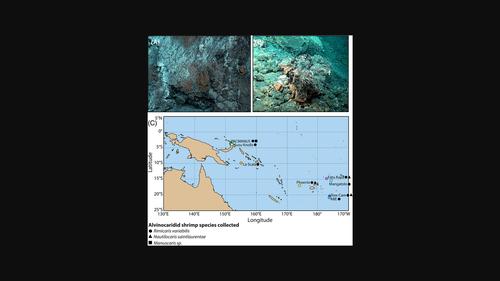当前位置:
X-MOL 学术
›
Environ. MicroBiol. Rep
›
论文详情
Our official English website, www.x-mol.net, welcomes your
feedback! (Note: you will need to create a separate account there.)
Symbioses of alvinocaridid shrimps from the South West Pacific: No chemosymbiotic diets but conserved gut microbiomes
Environmental Microbiology Reports ( IF 3.6 ) Pub Date : 2023-09-26 , DOI: 10.1111/1758-2229.13201 Pierre Methou 1 , Valérie Cueff-Gauchard 2 , Loïc N Michel 2, 3 , Nicolas Gayet 2 , Florence Pradillon 2 , Marie-Anne Cambon-Bonavita 2
Environmental Microbiology Reports ( IF 3.6 ) Pub Date : 2023-09-26 , DOI: 10.1111/1758-2229.13201 Pierre Methou 1 , Valérie Cueff-Gauchard 2 , Loïc N Michel 2, 3 , Nicolas Gayet 2 , Florence Pradillon 2 , Marie-Anne Cambon-Bonavita 2
Affiliation

|
Rimicaris exoculata shrimps from hydrothermal vent ecosystems are known to host dense epibiotic communities inside their enlarged heads and digestive systems. Conversely, other shrimps from the family, described as opportunistic feeders have received less attention. We examined the nutrition and bacterial communities colonising ‘head’ chambers and digestive systems of three other alvinocaridids—Rimicaris variabilis, Nautilocaris saintlaurentae and Manuscaris sp.—using a combination of electron microscopy, stable isotopes and sequencing approaches. Our observations inside ‘head’ cavities and on mouthparts showed only a really low coverage of bacterial epibionts. In addition, no clear correlation between isotopic ratios and relative abundance of epibionts on mouthparts could be established among shrimp individuals. Altogether, these results suggest that none of these alvinocaridids rely on chemosynthetic epibionts as their main source of nutrition. Our analyses also revealed a substantial presence of several Firmicutes and Deferribacterota lineages within the foreguts and midguts of these shrimps, which closest known lineages were systematically digestive symbionts associated with alvinocaridids, and more broadly for Firmicutes from digestive systems of other crustaceans from marine and terrestrial ecosystems. Overall, our study opens new perspectives not only about chemosynthetic symbioses of vent shrimps but more largely about digestive microbiomes with potential ancient and evolutionarily conserved bacterial partnerships among crustaceans.
中文翻译:

来自西南太平洋的alvinocaridid虾的共生:没有化学共生饮食,但保留了肠道微生物组
众所周知,来自热液喷口生态系统的Rimicaris exoculata虾在其扩大的头部和消化系统内拥有密集的附生菌群落。相反,该家族的其他虾类,被描述为机会主义饲养者,却受到较少的关注。我们结合使用电子显微镜、稳定同位素和测序方法,检查了其他三种alvinocaridids(Rimicaris variabilis、Nautilocaris saintlaurentae和Manuscaris sp.)“头部”室和消化系统的营养和细菌群落。我们对“头”腔内和口器的观察表明,细菌表观生物的覆盖率非常低。此外,在虾个体中,同位素比率和口器上表生物的相对丰度之间没有明确的相关性。总而言之,这些结果表明这些alvinocaridids都不依赖化学合成的表生物作为其主要营养来源。我们的分析还揭示了这些虾的前肠和中肠内大量存在多种厚壁菌门和去铁杆菌谱系,其中最接近的已知谱系是与alvinocaridids相关的系统消化共生体,更广泛的是来自海洋和陆地生态系统的其他甲壳类动物消化系统的厚壁菌门。总的来说,我们的研究不仅为虾的化学合成共生开辟了新的视角,更主要的是关于消化微生物组与甲壳类动物之间潜在的古老且进化上保守的细菌伙伴关系。
更新日期:2023-09-26
中文翻译:

来自西南太平洋的alvinocaridid虾的共生:没有化学共生饮食,但保留了肠道微生物组
众所周知,来自热液喷口生态系统的Rimicaris exoculata虾在其扩大的头部和消化系统内拥有密集的附生菌群落。相反,该家族的其他虾类,被描述为机会主义饲养者,却受到较少的关注。我们结合使用电子显微镜、稳定同位素和测序方法,检查了其他三种alvinocaridids(Rimicaris variabilis、Nautilocaris saintlaurentae和Manuscaris sp.)“头部”室和消化系统的营养和细菌群落。我们对“头”腔内和口器的观察表明,细菌表观生物的覆盖率非常低。此外,在虾个体中,同位素比率和口器上表生物的相对丰度之间没有明确的相关性。总而言之,这些结果表明这些alvinocaridids都不依赖化学合成的表生物作为其主要营养来源。我们的分析还揭示了这些虾的前肠和中肠内大量存在多种厚壁菌门和去铁杆菌谱系,其中最接近的已知谱系是与alvinocaridids相关的系统消化共生体,更广泛的是来自海洋和陆地生态系统的其他甲壳类动物消化系统的厚壁菌门。总的来说,我们的研究不仅为虾的化学合成共生开辟了新的视角,更主要的是关于消化微生物组与甲壳类动物之间潜在的古老且进化上保守的细菌伙伴关系。











































 京公网安备 11010802027423号
京公网安备 11010802027423号